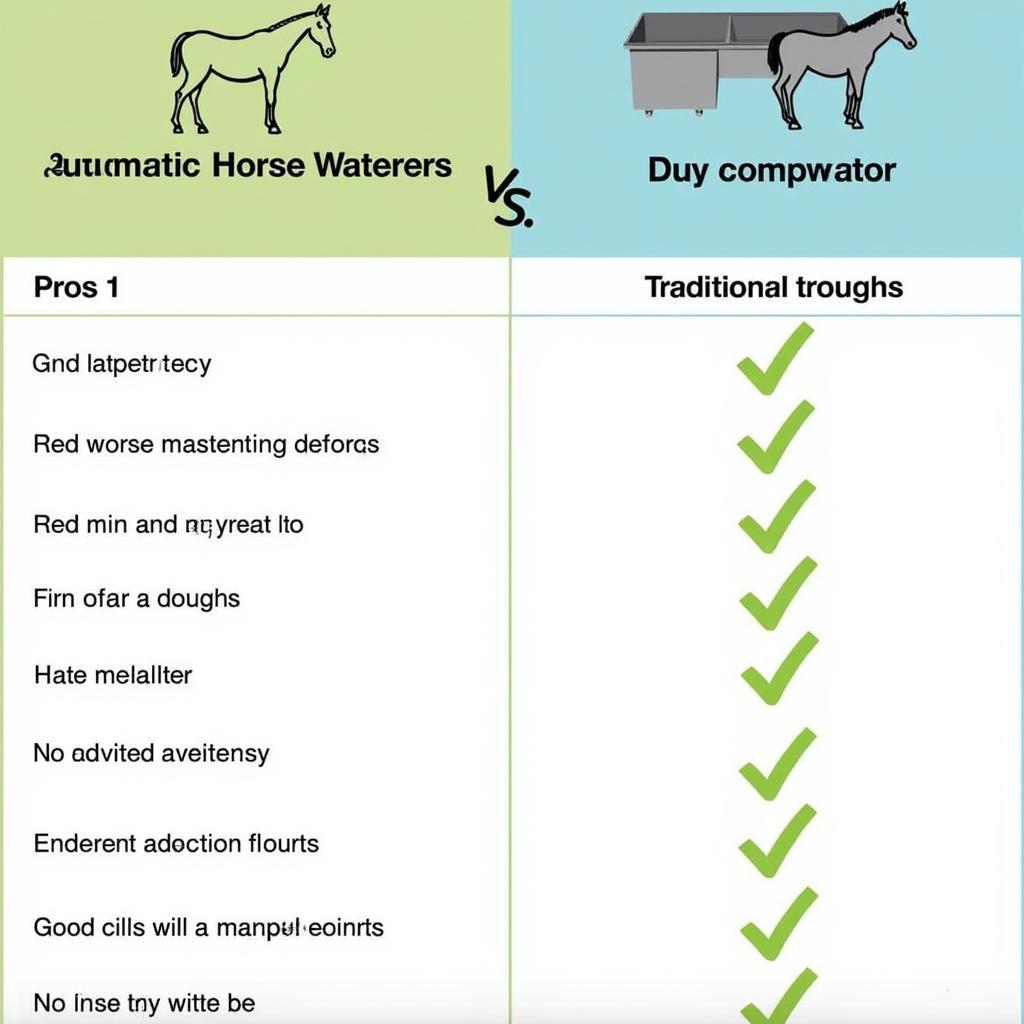Understanding Horse Trough Dimensions is crucial for ensuring your equine companion has access to fresh, clean water. The right size trough promotes healthy hydration and prevents water wastage. Whether you’re setting up a new pasture, renovating your stable, or simply replacing an old trough, this comprehensive guide will equip you with the knowledge you need to choose the perfect horse trough dimensions for your specific needs.
Factors Affecting Horse Trough Dimensions
Several factors influence the ideal horse trough dimensions for your horses. Consider the following:
- Number of Horses: The more horses you have, the larger the trough needs to be. A small trough for a large herd will lead to crowding and potential injury.
- Horse Size: Larger horses naturally require more water than ponies or miniatures. A standard-sized trough may be too small for a draft horse, while a large trough could be overwhelming for a smaller equine.
- Climate: Horses drink more in hot weather, so a larger trough is necessary in warmer climates. In colder climates, a smaller trough may suffice, but ensure it doesn’t freeze over.
- Turnout Time: Horses that spend more time in the pasture will need access to a larger water source than those stalled for extended periods.
- Water Source: If you have a reliable automatic waterer, the trough capacity might be less critical. However, a backup trough is always recommended in case of power outages or malfunctions.
Standard Horse Trough Dimensions
While there’s no one-size-fits-all answer, some general guidelines for horse trough dimensions can help you get started. A good rule of thumb is to allow for 1-2 inches of trough perimeter per horse. For example, a 4-foot diameter round trough would be suitable for approximately 6-12 horses.
- Small Troughs: Ideal for individual horses or small paddocks, these troughs typically hold 10-20 gallons. They are often portable and easy to clean.
- Medium Troughs: Suitable for 2-4 horses, these troughs usually hold 30-50 gallons and are a good choice for small pastures or shared paddocks.
- Large Troughs: Designed for larger herds or high-traffic areas, these troughs can hold 80-100 gallons or more. They are often made from durable materials like concrete or galvanized steel.
Calculating the Right Horse Trough Dimensions
To determine the ideal horse trough dimensions for your situation, consider the following calculation: Multiply the number of horses by their average weight (in pounds) and then divide by 50. This will give you an estimated gallon capacity for your trough.
For example, if you have four 1,000-pound horses, you’ll need a trough that holds approximately 80 gallons (4 x 1000 / 50 = 80).
What are the common horse trough dimensions?
Common horse trough dimensions vary widely depending on the manufacturer and intended use. However, you can find troughs ranging from small, individual units to large, multi-horse troughs. You might find yourself needing [hay racks for horse trailers] if you’re transporting your horses over long distances.
“Choosing the correct trough size is essential for maintaining your horses’ health and well-being,” advises Dr. Emily Carter, DVM, an equine veterinarian with over 20 years of experience. “Adequate water intake is critical for digestion, performance, and overall health.”
 Automatic Horse Waterers vs. Traditional Troughs: A Comparison
Automatic Horse Waterers vs. Traditional Troughs: A Comparison
Conclusion
Selecting the appropriate horse trough dimensions is a crucial aspect of horse ownership. By considering factors such as herd size, climate, and turnout time, you can ensure your horses have access to the water they need to thrive. Remember, providing fresh, clean water in a properly sized trough is an investment in your horses’ health and happiness. Do you need a [stable for toy horses]?
FAQ
- What material is best for a horse trough? Galvanized steel and concrete are popular choices for their durability. Plastic and rubber troughs are lighter and easier to move, but may not be as long-lasting.
- How often should I clean my horse trough? Cleaning should be done regularly, at least once a week, to prevent algae growth and bacteria buildup.
- Can I use a stock tank as a horse trough? Yes, stock tanks are often used as horse troughs, but make sure the plastic is food-grade and safe for horses.
- How do I prevent my horse trough from freezing in the winter? Heated troughs or trough de-icers can prevent freezing in colder climates.
- What is the average water intake for a horse? A horse can drink anywhere from 5 to 15 gallons of water per day, depending on factors like size, activity level, and weather.
- How high should a horse trough be? The ideal height is generally at the horse’s withers to allow for comfortable drinking.
- Can I build my own horse trough? Yes, DIY horse troughs are possible, but ensure they are sturdy, safe, and made from appropriate materials. You may even consider building a [DIY run in shed for horses].
Other Questions
What about [horse pills size]?
When you need support, please contact Phone Number: 0772127271, Email: [email protected] Or visit us at: QGM2+WX2, Vị Trung, Vị Thuỷ, Hậu Giang, Việt Nam. We have a 24/7 customer support team.